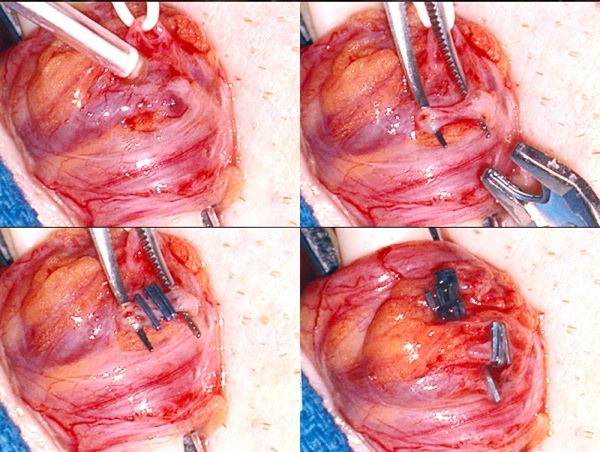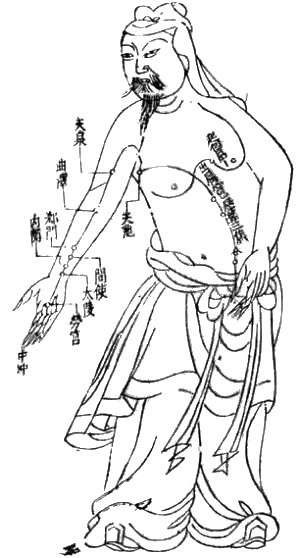May 25th, 2012 § § permalink
Mr. Smith asked me to explain the different methods of treating varicose veins in the scrotum known as a varicocele. There are a few:
- A surgeon makes a small incision in the groin, and ties or clips the veins. The surgeon may use an operating microscope or wear glasses with magnifying lenses to preserve small arteries supplying blood to the testis.
- A surgeon uses a telescope called a laparoscope to find the veins inside the abdomen and tie or clip them.
- A radiologist threads a small tube through the veins and injects material to plug them.
Most surgeons who specialize in male fertility prefer to use an operating microscope or wear glasses with magnifying lenses to perform the procedure, but excellent results can be obtained with either laparoscopy or radiology. A man should ask his doctor about his or her experience, what he or she prefers and why.
This series of pictures shows what the procedure looks like under the operating microscope. The surgeon uses a small probe to listen to the veins as they sound different than arteries. In this procedure, titanium clips were used to block the veins, but surgical suture can also be used.

Thanks, Mr. Smith, for asking a great question!
February 21st, 2012 § § permalink
SpermCheck has arrived and is filling the shelves of your neighborhood drug store as I write. What is it? It’s an over-the-counter FDA approved home male fertility test. What does it do? It tells you whether you have more than 20 million sperm per milliliter of semen.
That’s a good thing, right? Generally, yes. It’s good to know whether you have a reasonable amount of sperm, which SpermCheck says is 20 million per milliliter. The problem is in the yes-or-no nature of the test and in picking the number 20 million. As I described in this post, you can get a woman pregnant with sperm counts less than 20 million per milliliter and have problems with more than that amount. The numbers of swimmers don’t tell the whole story.
So, will SpermCheck help you? For most men, probably. Having a positive or negative result will point them in the right direction. But for the handful of guys that get the OK from the test when they have a problem or for those that get the thumbs-down from the test that are fertile, it’s not telling the whole story. According to the manufacturer, the guys that are getting it wrong is about one in twenty. If you’re OK with that, great–if not, you may want to see a doctor.
August 16th, 2011 § § permalink
By Eve Feinberg, M.D.
Fertility Myths
Myth #1: Missionary position is best.
As long as intercourse is vaginal (and yes, strangely, I have had a few couples who had not grasped this detail prior to their first consultation), position does not matter. Sperm are incredible swimmers and studies have shown that within minutes of intercourse the sperm can be found within the fallopian tubes and will get to where they need to be expeditiously.
Myth #2: You should lie still for 30 minutes after intercourse with your legs in the air.
Sperm are incredible swimmers (see #1). It will not decrease your likelihood of conceiving if you use the bathroom or walk around within minutes of intercourse.
Myth # 3: I got pregnant and had an abortion in high school, so I am highly fertile.
Most high school students are highly fertile, but fertility declines with advancing age. Girls are born with a set number of eggs and over the course of a woman’s reproductive life, the number of eggs declines dramatically. There are several critical periods where the decline is more steep and after the age of 45, there is such little benefit to IVF using your own eggs, that most clinics will not perform IVF on a 45 year old woman attempting conception with her own eggs. On a good note, having had an abortion does not make you infertile.
Myth #4: I am a “young” 40.
Aging occurs at a variable rate when it comes to gray hair and wrinkles. Ovarian aging, unfortunately, is quite predictable. Your ovaries will never act younger than your chronological age. They may respond more robustly than expected and may give you a higher yield of eggs, but the quality of those eggs is linked to a woman’s age. And sadly, egg quality and quantity decrease markedly with advancing age.
Myth #5: If you relax, you will get pregnant.
There are very few cases where the sole cause of infertility or IVF success is stress. This is a common perception and often a hurtful thing to say to an infertile couple. Infertility is a medical condition with identifiable, organic causes in the majority of cases. There has not yet been a well designed study that shows the positive impact of stress reduction on conception success.
I hope you’ve enjoyed Fertility Myths (and my VERY FIRST) blog entry ever. I am excited to be on the blogosphere and welcome your comments or suggestions for new topics.
July 20th, 2011 § Comments Off on Needles and Sperm § permalink

A reader recently asked whether acupuncture helps sperm.
I have to admit I’m a Western thinker, but that doesn’t mean that I automatically dismiss anything Eastern. It does mean that, as is true of any treatment, I will want to see evidence of effectiveness before I believe that it works. The most compelling proof will include:
- A comparison of those patients who are treated and those who are not,
- Patients (and preferably doctors) who don’t know which patients are being treated and which are not,
- Statistics that demonstrate the chances that the conclusion is wrong,
- More than one study that says it is right.
A number of published studies report how sperm fares with acupuncture. One, published in Fertility and Sterility in 2009, described the use of a special device that either performed acupuncture or just looked like it did, so that patients did not know whether or not they were being treated. Comparing men who were actually treated to those who weren’t, the authors could say with around 95% confidence that motility after acupuncture increased about 10%. The authors didn’t observe an increase in sperm count, and semen volume decreased a little.
If effective, acupuncture would be a great treatment for men who need to improve motility. But first, I’d like to see a study similar to the one done in 2009, but from different investigators and showing similar results. Until then, I’d say acupuncture looks promising but needs a bit more study.
June 7th, 2011 § § permalink
May blew by, and I didn’t manage a single new post. The annual meeting of the American Urological Association and a big burst of research activity in my bioengineering lab did keep me busy, but really, there’s no good excuse, and it’s time to blog again.
One very active area of this blog is How Clomid Works in Men, with over a hundred comments to date. I’m grateful to Robert for inspiring this post. His question is, are there medications that decrease estrogen?
To review how the pituitary controls the making of testosterone in the testis, testosterone is converted to the female hormone estrogen, and rising levels of estrogen tell the pituitary to make less luteinizing hormone (“LH”). The role of LH in a man is to stimulate the testis to make testosterone, and as the pituitary sees more testosterone in the blood through the lens of estrogen, it tells the testis to make less testosterone by reducing LH. I likened this negative feedback system to a thermostat and a heater: as the room becomes hotter, the thermostat turns down the heater. Clomiphene binds tightly to the pituitary, (and hypothalamus for you biological sticklers), and tricks the pituitary into thinking less estrogen is bouncing around in the bloodstream. The pituitary labors to make more LH as a result, and the testis makes more testosterone. The drug tamoxifen works in a similar way.
But Robert’s question hinted at another way to trick the pituitary: there is a way to decrease estrogen directly so that the pituitary sees less of it and makes more LH.
The enzyme aromatase turns testosterone into estrogen. Drugs like anastrozole and testolactone block aromatase, causing estrogen to decrease in the blood. The pituitary makes more LH as a result, and the testis produces more testosterone. If a man has low testosterone and high estrogen, these drugs can simultaneously increase testosterone and decrease estrogen. In a study published in the Journal of Urology in 2002, doctors Raman and Schlegel report evidence that anastrozole seems to work a little better than testolactone, at least in terms of increasing sperm production. In that study, the doctors also suggest that these drugs are best used if the ratio of testosterone is less than ten to one.
As I wrote in my post on How Clomid Works in Men, all of these drugs are off-label for use in the male, meaning that the Food and Drug Administration didn’t approve their use in men. That doesn’t mean that they can’t be used. It means that doctors need to tell patients what we know about these drugs, allowing for an informed decision on their use. It also means that many of the questions we have about these drugs don’t have answers. A good question about aromatase inhibitors in men is whether estrogen plays an important role in some health concerns in men, and if it is decreased for a long period of time, can other health problems occur? We don’t know. My current practice for prescribing aromatase inhibitors is mostly to limit their use to male fertility, and to stop the medication as soon as possible.
So there you have the two basic ways that pills can trick the pituitary into telling the testis to make more testosterone. Thanks, Robert!


